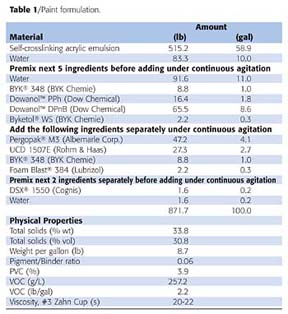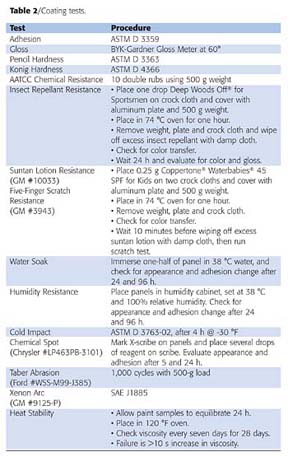New Self-Crosslinking Emulsion Polymer for Interior Automotive Rigid Plastic Substrates

Emulsion polymers have been used in coatings for automotive interior plastics. However, to provide the required performance, they typically must be crosslinked, which can increase costs, handling problems and toxicity. These problems can be avoided by using a self-crosslinking system, but such systems usually do not provide the required chemical resistance.
A new waterborne self-crosslinking acrylic polymer has been developed to improve the performance of these systems in automotive interior plastics. The polymer exhibits outstanding adhesion to a variety of rigid plastic substrates and demonstrates excellent chemical resistance. It also provides the flexibility and wear resistance required for interior automotive plastics coatings. The chemical resistance is equivalent to that of crosslinked systems, and the polymer shows improved adhesion and metallic pigment compatibility.

Polymer Requirements
The two critical challenges for waterborne coatings used on rigid plastics in automotive interiors are adhesion and chemical resistance. Many different plastics are used with varying adhesion properties. Coatings used on these plastics not only must be compatible with all the substrates that might be encountered but also must resist deterioration from a wide variety of chemicals.For example, the coatings must demonstrate chemical resistance to suntan lotions, insect repellants (DEET), protectants, ethanol, isopropanol, soaps, and window and surface cleaners.
The challenge in assessing these properties is that each automaker has its own specification for automotive interior coatings. Test methods vary widely from company to company, as do performance requirements. Thus, a number of tests must be run to ensure that a coating meets the requirements of each company.
Rigid plastics commonly used in automotive interiors include acrylonitrile butadiene styrene (ABS), polycarbonate (PC), ABS-PC blends, Noryl, polystyrene and high-impact polystyrene (HiPS). Adhesion and chemical resistance properties of coatings used on these substrates can be maximized through the careful design of the polymer backbone. In addition, coalescent solvents and additives used in coating formulations also affect chemical resistance and adhesion.
The morphology of emulsion polymers can affect block resistance, hardness development and minimum film formation temperature. It also allows coatings formulators to optimize a formulation for a particular application.
In general, coatings based on conventional emulsion polymerization using monomers such as acrylates and styrene cannot provide sufficient chemical resistance for automotive interior plastics. Usually, crosslinking systems are required to provide the necessary performance. Although a variety of crosslinking chemistries are available, one-pack crosslinking is preferred because these formulations are easier to handle in the field and they provide more formulation flexibility. However, such systems usually do not provide performance properties equivalent to those of two-pack systems.
A one-pack emulsion polymer has been developed for interior automotive plastic coatings that provides performance equivalent to that of two-pack systems. The polymer demonstrates good adhesion to a variety of substrates, excellent chemical resistance and good compatibility with metallic pigments.

Polymer Design
Factors to consider in designing, developing and optimizing emulsion polymers include:- reactive functional groups/concentration;
- co-monomer selection;
- surfactant types;
- glass transition temperature, Tg, and
- morphology.
For optimum performance, crosslinking reactions must be blocked in the aqueous phase until adequate film formation is completed. Reactive groups must be stable during this period because premature crosslinking reactions prior to film formation adversely affect film integrity.
Surfactant choice also affects adhesion and stability. In addition, the surfactant plays a significant role in the water sensitivity of the finished film. The new polymer uses a proprietary surfactant to provide the required performance.
Glass transition temperature is related to the hardness of the polymer. Generally, high-hardness coatings are preferred for rigid plastic surfaces in auto interiors.
Morphology has a direct effect on block resistance and minimum film formation temperature. It also controls the amount of flexibility a coating formulator has in developing or adapting the formulation. The new polymer gives paint formulators the flexibility needed to optimize a formulation for different applications.
Finally, the performance of acrylic emulsion polymers can be enhanced by blending with polyurethane dispersions. Many patents and articles describe the benefits of blending or hybridizing polyurethane dispersions and acrylic emulsions. In general, blending acrylic emulsions with polyurethane dispersions improves flexibility, toughness, abrasion resistance, chemical resistance and film formation.

Test Results
Performance properties of the self-crosslinking polymer were compared to those of commercially available polymers. The basic coating formulation is listed in Table 1 (page 112). For polymers with different glass transition temperatures or morphologies, the amount of solvent was adjusted to ensure good film formation.
The formulated paints equilibrated overnight before they were drawn down over various substrates. Plastic plaques were coated with 1.0 mil DFT paint applied with a conventional air spray gun at 65-psi pressure followed by 20 min flash off at room temperature. Plaques were then cured at 170 °F (77 °C) for 30 min. All test panels were allowed to equilibrate for 72 h at room temperature before testing (unless specified otherwise in the OEM specification).

The results show that the new polymer performs better than or equal to a benchmark emulsion polymer used in interior automotive plastic applications. The new polymer also exhibits excellent adhesion to a variety of plastic substrates.
For further information, contact Prashant Patel, global marketing manager for Noveon's Performance Coatings group, at prashant.patel@noveon.com or 216/447.5568.
Looking for a reprint of this article?
From high-res PDFs to custom plaques, order your copy today!






